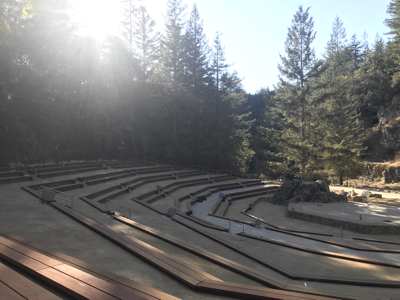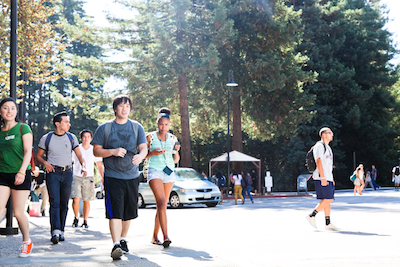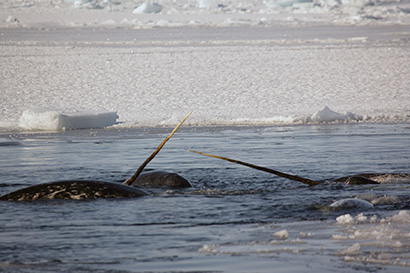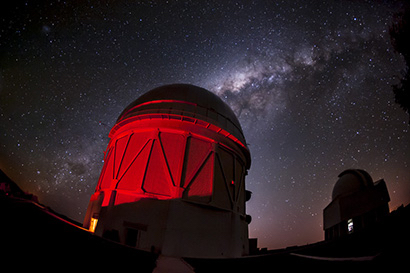At UC Santa Cruz, the 12 months of 2017 were full of discoveries, explorations, and going where no one has gone before. But the year was also a time of revived traditions that allowed students, staff, and faculty to revisit the past, while reimagining and updating those visions.
A prime example was the grand reopening this fall of the Quarry Amphitheater, a lovely, long-shuttered hot spot where César Chávez, Angela Davis, Buckminster Fuller, and Joan Baez once spoke to rapt crowds. The university marked the $8 million project’s completion—funded in large part by student fees—at a ceremony in October, complete with a marching band and a flashy show by the UC Santa Cruz Kahaani dance team. But the amphitheater got its first real taste of new life when the popular band Chicano Batman rocked the 2,000-capacity joint later that month.
Breaking records, breaking ground
That Quarry Amphitheater completion was just one of the hallmarks of an even more ambitious undertaking at UC Santa Cruz—the campus’s first comprehensive campaign, which came to a dramatic and triumphant close this year after raising $335 million. These funds have already reaped dividends—the Quarry Amphitheater restoration was one of the key initiatives. The campaign is also supporting the Genomics Institute, the Coastal Sustainability initiative, the Institute of the Arts and Sciences, scholarships, fellowships, and other worthy projects and causes.
“It is hard to overstate the positive impact the Campaign for UC Santa Cruz is having on our campus,” said Chancellor George Blumenthal, close to the end of the campaign. “When I look around, I see it everywhere: the rebuilt Hay Barn near the main entrance, the renovated Quarry Amphitheater in the heart of campus, new academic programs and scholarships for our students, research and teaching support for our faculty, new cultural programs and archives, deeper engagement with our alumni and community.”
Other fundraising efforts also made a big impression, including Fall Into Philanthropy, a month-long fundraising effort inspired by the same spirit of generosity and community that has driven UC Santa Cruz’s annual Giving Day events.
The campaign, which kicked off on October 16 and ended on November 15, put the spotlight on programs such as the Smith Renaissance Society; People’s Media Advocacy, Asia; the Undergraduate Research Fund for Science and Engineering; the Everett Program; and Randall Morgan Collections and UC Santa Cruz Santa Cruz Natural History Initiative, as well as Alumni Association scholarships, undergraduate scholarships, Slug Support, and the UC Santa Cruz Fund.
Alumni leave their mark on the writing world
Meanwhile, Banana Slugs expanded their reach and their influence in many fields, including journalism, while sustaining the campus’s proud traditions of social responsibility.
Washington Post correspondent and UC Santa Cruz alumnus Nick Miroff was awarded a 2017 Maria Moors Cabot Prize for his reporting in Latin America. UC Santa Cruz humanities alumnus Michael Scherer (Oakes ‘98, creative writing) joined the Washington Post as a national political reporter in September.
UC Santa Cruz-educated literary writers continued to win hearts and minds with their creative work and reportage. The tireless and boundlessly creative alumna Kate Schatz (Stevenson '01, women's studies and creative writing) scored her second New York Times bestseller with her latest work, Rad Women Worldwide. Amy Ettinger (Merrill ’95, American literature) received a glowing review in the Wall Street Journal, and was featured on NPR’s Marketplace and All Things Considered, for her book Sweet Spot: An Ice Cream Binge Across America.
This year, a pair of alumni, Roxanne Beltran (Stevenson, ‘13, marine biology_ and Patrick Robinson (Rachel Carson, ‘03, marine biology), made a real splash with a new, 48-page children’s book published by the University of Alaska Press titled A Seal Named Patches, which sold out half its 2,000-volume printing within two weeks of its release.
On November 29, A Seal Named Patches was announced as the 2017 winner of the DeBrary Outstanding Science Children's Book award. “This book probably has more impact than any individual scientific paper we’ve written in terms of sheer readership and impact on readers,” said Robinson, director of the UC Natural Reserve at Año Nueno.
Faculty and researchers take on big issues
No problem or challenge was too daunting for the UC Santa Cruz’s faculty this year. A new study by scientists at UC Santa Cruz and the University of Cantabria, Spain, identified hotspots where half a million people along the coast face hurricane risks in Latin America and the Caribbean.
Also this year, UC Santa Cruz scientists peered deeply into the realm of wildlife, revealing secrets and dreaming up new solutions, while exposing some troubling problems. Terrie Williams, professor of ecology and evolutionary biology, was first author of a paper describing narwhals’ responses to new stressors caused by melting sea ice. Meanwhile, analysis of DNA recovered from museum specimens explained the surprisingly low genetic diversity of the now-extinct passenger pigeon.
Proud Banana Slugs bring about ‘real good’ change
Faculty were not the only ones to use their formidable problem-solving skills and creativity to bring about real solutions to intractable issues. Determined Banana Slug alumni also did their part.
Axel Alonso (Cowell ’87, sociology) worked hard to make comic book characters more reflective of real world demographics, becoming a “diversity superhero” in the process.
Alan Lovewell (Cowell ’05, art) made a mark of his own by championing—as well as rewarding—sustainable fishing practices. He is president of Real Good Fish, headquartered in Moss Landing. This company connects small-scale fishermen directly with consumers through weekly deliveries of seafood that range from fresh-caught Dungeness crab to wild salmon and sand dabs. “The idea is that we want healthier oceans and to eat healthier food so we have to have closer ties” between consumers and suppliers, said Lovewell.
Another headline-making Banana Slug, Natalie Batalha (Ph.D ‘97 astrophysics) made Time magazine's list of the 100 most influential people on Earth, and for very good reason: she has discovered approximately 4,000 new planets—some of which may turn out to be capable of supporting life.
The Slug also rises
With so much good work going on up on campus, it is not surprising that the popularity of UC Santa Cruz soared this year among aspiring high school students hoping for a place in the freshman class. In fact, undergraduate applications reached a record high, showing increased interest from California students and those from other states and countries seeking a university experience centered on student success and driven by breakthrough research and innovation that continues to gain national and international recognition.
More than 52,000 students—a new record—applied to be new first-year students for the fall 2017 quarter, a 6.9 percent increase from the previous year. UC Santa Cruz saw a 6.4 percent increase in the number of California high school seniors applying. Worldwide awareness continues to grow about the campus’s blend of high-impact research with tight-knit communities of learning, similar to small liberal arts colleges. Applications from out-of-state students increased by 2.5 percent and from international students by 13 percent.
There was also increased interest from ethnically diverse California students. The campus received more freshman applications from African Americans (6.5 percent more); from Asian Americans and Pacific Islanders (5.7 percent more); and Chicanos/Latinos (11 percent more).
Gazing at the stars
If you want to talk to people who know what it is like to journey through the sky into realms where no one has gone before, have a chat with one of UC Santa Cruz’s celebrated astronomers and physicists. This year a groundbreaking UC Santa Cruz team made the first observations of a visible event linked to the detection of gravitational waves, opening a new window into understanding the physics of neutron star mergers—and possibly resolving an age-old question: where does gold come from?
On a more somber note, the university bid farewell to Jerry Nelson, a pioneering astronomer known for his innovative designs for advanced telescopes, who died in June at 73. A professor emeritus of astronomy and astrophysics at UC Santa Cruz, Nelson was project scientist for the Thirty Meter Telescope (TMT) and had served as project scientist for the W. M. Keck Observatory in Hawaii from 1985 through 2012.
Nothing escaped the gaze of UC Santa Cruz faculty, including the mysteries of dark matter and energy. Physicist Tesla Jeltema investigated these phenomena by studying clusters of galaxies, the largest assemblies of matter in the universe.
An associate professor of physics at UC Santa Cruz, Jeltema is deeply involved in the Dark Energy Survey (DES), a large international collaboration to measure the effects of dark matter and dark energy on the expansion of the universe and the growth of large-scale structures like galaxy clusters over time. She co-chairs the galaxy clusters working group and leads one of the cluster analysis teams for DES, among other responsibilities
Growing pride
When UC Santa Cruz community members gathered at the reopening of the Quarry Amphitheater, they were hailing an old tradition while marking and celebrating its continuing relevancy. This was also the case with sustainable farming at UC Santa Cruz, which celebrated its 50th anniversary this year. The tradition started with a fledgling organic gardening movement at UC Santa Cruz in 1967; that ongoing sustainable growing practice is now recognized as the oldest university-based organic research and education facility in the country.
“It's the people's farm," says Daniel Press, professor of environmental studies and executive director of the internationally acclaimed, hands-on learning and research programs housed at UC Santa Cruz. "What began as a student- and faculty-initiated idea to create a garden as a place for repose, renewal, and connection is, today, an incredibly well-rounded resource that exists to serve and inspire people."






